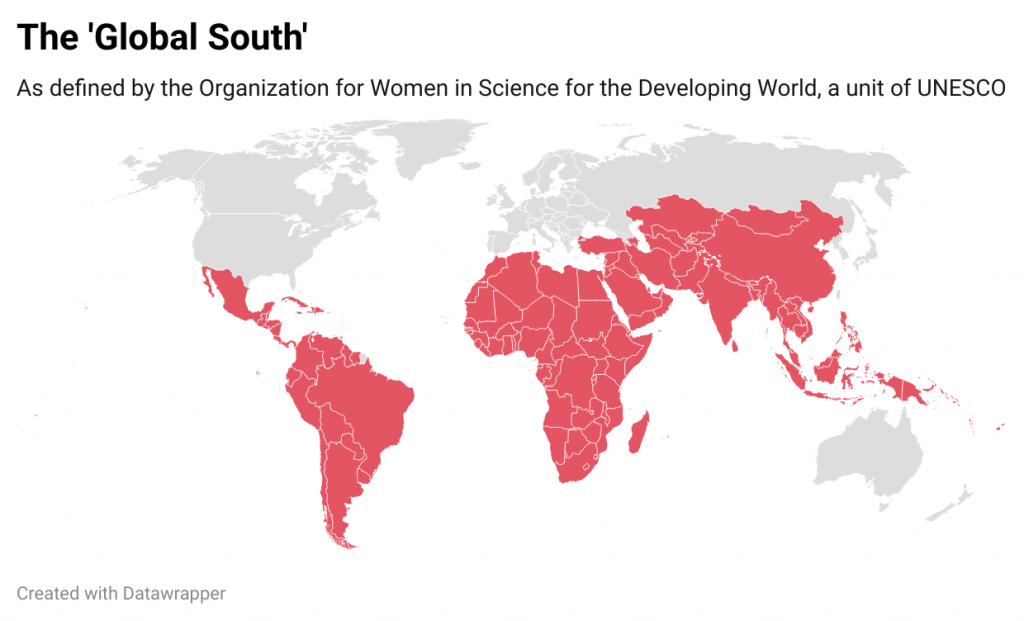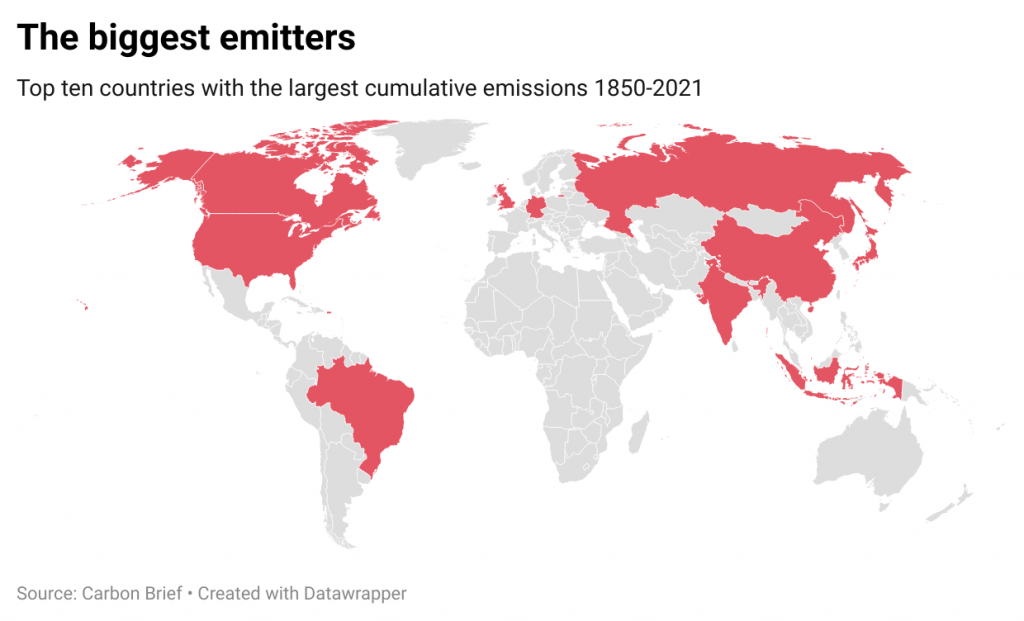What’s in a name? For the ‘Global South,’ it depends on who you ask

The 'Global South' has never been easy to define. Grouping such a diverse range of places together under a single label can seem simplistic. That's particularly true at a time when these countries are asserting themselves in different ways on issues like climate action and conflict.
I’m writing this piece about the “Global South,” which is something people in relatively comfortable places well north of the equator tend to do. I’ve certainly used the term before, but I’m never completely comfortable lumping the bulk of humanity into a nebulous catch-all.
And I’m not alone.
It’s not necessarily a minor point. Global South is useful shorthand for an increasingly assertive expanse of the world traditionally on the losing end of global inequality, and long afforded limited geopolitical influence. Those dynamics may be changing, but the region's definition remains squishy.
The Global South’s early outlines were sketched out in 1955, when a conference in Indonesia brought together delegates from “Non-Aligned” countries navigating a path between opposing powers during the Cold War.
By that point, the term “third world” had been coined by a French demographer as an alternative to “Non-Aligned,” and soon started appearing in news stories elsewhere. But it eventually took on a negative connotation that was more about hierarchy than sovereignty (for many people, “developing countries” isn't much better).
“Global South” rose to prominence as a term in the early 1990s, when the Cold War was fading. It had initially appeared in a magazine piece a couple of decades earlier, describing the “intolerable social order” of an international system dominated by the North.
Those bad feelings have lingered.
The president of the World Bank said recently he’s kept up at night by the “mistrust that is quietly pulling the Global North and South apart at a time when we need to be uniting.” The Global South’s frustration, he added, is “understandable.”
After all, it accounts for an estimated 85% of the global population, but less than 40% of global GDP.

Clearly defining the 'Global South' has never been a straightforward task. Image: World Economic Forum
Increasingly, though, the Global South is forming a key swing vote in global affairs by weighing in on issues like Russia's invasion of Ukraine.
That doesn't make it any easier to adequately define.
Economic status is one way to account for the ties that bind its members. By that measure, though, should Chile still belong to the Global South? It’s also in the OECD, a forum for just a few dozen of the "most developed" countries. Costa Rica, also regularly grouped into the Global South, became the OECD’s most recent entrant in 2021.
The Global South is also typically defined to include the second- and fifth-biggest economies in the world. And China and India are not just numbers two and five, respectively – they’re on track to become one and two. The UAE and Saudi Arabia are also simultaneously in the Global South and among the fastest-growing economies; other members are gaining ground even more quickly.
Still another flaw in strictly classifying according to GDP is that it could theoretically qualify less-wealthy countries in Eastern Europe for the Global South. Just to make things a bit more complicated, though, it’s been suggested that these places actually constitute their own distinct group: the Global East.
Other ways to think about the ‘Global South’
Better maybe to simply rely on geography as a guide.
It’s just that Global South members like Kazakhstan and Mongolia have map coordinates that are far more north than south. And there are also Australia and New Zealand, members of the Global North located in the Southern Hemisphere, to consider.
In the 1980s, the Brandt Line was concocted as a kind of economic development-based equator neatly distinguishing the more prosperous North from the South. Australia and New Zealand were unavoidable exceptions; the makeshift geographical boundary eventually faded completely when people realized it also didn’t make much sense to have places with enviable levels of GDP per capita like Bahrain or Malaysia sitting beneath it.
So, geography’s not the best measure. It could be that a clearer distinguishing characteristic is a country’s history of being colonized.
By that standard, of course, the US (occupier: the British) and the British (occupiers: the Vikings, the Normans) might qualify for the Global South.
Yet, neither of those countries would ever be mistaken for traditional anti-colonialists. Not by a long shot. And that seems to be the dividing line – not just experiencing the receiving end of colonialism, but actively working to build a world that’s free of it.
Even that distinction can can get fuzzy, though.
The historian Timothy Snyder has argued that a victory for Ukraine in its fight to expel Russia would strengthen the principle of sovereignty, including in post-colonial countries in the Global South. But some see hypocrisy in the West (yet another imprecise label) rallying around the concept of sovereignty in Europe, after frequently disregarding it elsewhere.

The flip side; the biggest emitters tend to be located in the Global North. Image: World Economic Forum
Here’s one way to at least attempt to define the Global South: it’s everything outside of those wealthy countries that have pumped most of the harmful emissions into the atmosphere since the Industrial Revolution.
And it includes countries poised to suffer the worst impacts of resulting climate change, even as they contribute relatively little to the problem. Africa is already dealing with withering, climate change-related droughts and devastating floods, according to the World Meteorological Organization, though it only generates about 3% of global greenhouse gas emissions.
This definition is lacking some clarity now too, however.
That’s because some countries traditionally included in the Global South are developing carbon footprints far surpassing even those of their peers in the Global North.
It’s true that things need to be simplified whenever they can, to try to help as many people as possible understand complex global problems. When it comes to the term “Global South,” there just might be no simpler and clearer alternative available. For now, anyway.
That World Bank president who recently flagged growing mistrust between the regions was born in the Global South, to a Sikh family in India, where he started his career. But he later relocated to the US, in the Global North.
A bit of both in one person, then, who may not be so easy to define.
More reading on what defines the ‘Global South’
For more context, here are links to further reading from the World Economic Forum's Strategic Intelligence platform:
- A champion for the Global South? According to this analysis, the world is waking up to the fact that global problems cannot be worked out without India’s involvement. (The Diplomat)
- “How Europeans can get real with the Global South.” According to this piece, that means reimagining multilateral institutions, and building credibility through partnerships that go beyond traditional aid and lending. (European Council on Foreign Relations)
- “Waste pickers know that there are toxic chemicals in plastic but we still make sure we recover them and save the environment.” Some of the most essential workers in the Global South have been pressing for greater rights and recognition, according to this piece. (Eco-Business)
- Nearly 5% of the nursing workforce in the US is now Filipino, as the Philippines faces a domestic shortfall of some 350,000 nurses. According to this piece, the Global North can’t keep recruiting its health care workers from the Global South. (STAT)
- Wealthy countries have failed to the deliver the $100 billion in annual funding for climate adaptation promised to their less-wealthy peers, and according to this piece 70% of what has been received is in the form of loans – which could drive countries further into debt. (Eco-Business)
- These researchers developed a new way to measure urban areas. One of their most surprising takeaways: 30 times less of the built-up infrastructure correlating with economic growth in cities in the Global South, compared with those in the Global North. (Science Daily)
- This 18-month-long project exploring perspectives on Europe’s international role through the eyes of the Global South was inevitably impacted by responses to the pandemic, and delivered some “sobering lessons.” (Carnegie Endowment for International Peace)
On the Strategic Intelligence platform, you can find feeds of expert analysis related to Global Governance, Inequality and hundreds of additional topics. You’ll need to register to view.
John Letzing Digital Editor, Strategic Intelligence, World Economic Forum.
This first appeared on the Agenda blog.
Photo by Emre Bilgiç


